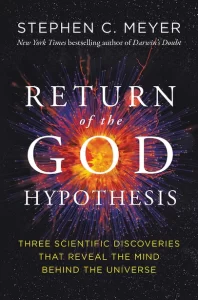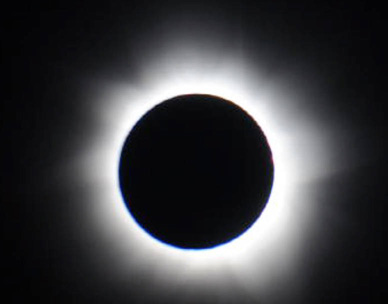Dr. Ray Bohlin concludes a four-part series covering some of the big ideas in Dr. Stephen Meyer’s book ‘Theistic Evolution’ by examining some of the theological problems with this perspective.
Did God Create a World with Pain and Suffering Already In It?
In this article I review the theological critique of theistic evolution from the book, Theistic Evolution: A Scientific, Philosophical, and Theological Critique. (I have previously written on the scientific problems here and here, and the philosophical problems here.) First, I review a chapter in the philosophical section, “Bringing Home the Bacon: The Interaction of Science and Scripture Today” by Colin R. Reeves. I’m focusing on Reeves’s section on theistic evolution’s problem with theodicy.
 A theodicy seeks to explain God’s reasons for allowing evil. He says that many conservative Christians who have embraced theistic evolution simply view natural evil as having always existed. He writes, “If natural evil is of necessity a part of evolutionary history, and if evolution is the process instituted by God to, in the end, result in creatures on earth with whom he could have a relationship, then it follows that God is the direct cause of natural evil – it is part of his plan.”{1} Reeves quotes evolutionary philosopher David Hull: “The God implied by evolutionary theory . . . is careless, wasteful, indifferent, almost diabolical . . . not the sort of God to whom anyone would be inclined to pray.”{2} Hull’s solution is to simply reject any notion of God. He mentions theologian Christopher Southgate struggling with this problem. How does one “redeem” the notion that pain, suffering, and death are intrinsic to evolution, which Southgate accepts? Southgate settles for an underwhelming notion of what he calls a “pelican heaven,” symbolizing the hope that everything will be fine in the end. That is just bizarre. This seems to recognize the problem, but seeing no solution, this idea simply hopes that God has it figured out somehow.
A theodicy seeks to explain God’s reasons for allowing evil. He says that many conservative Christians who have embraced theistic evolution simply view natural evil as having always existed. He writes, “If natural evil is of necessity a part of evolutionary history, and if evolution is the process instituted by God to, in the end, result in creatures on earth with whom he could have a relationship, then it follows that God is the direct cause of natural evil – it is part of his plan.”{1} Reeves quotes evolutionary philosopher David Hull: “The God implied by evolutionary theory . . . is careless, wasteful, indifferent, almost diabolical . . . not the sort of God to whom anyone would be inclined to pray.”{2} Hull’s solution is to simply reject any notion of God. He mentions theologian Christopher Southgate struggling with this problem. How does one “redeem” the notion that pain, suffering, and death are intrinsic to evolution, which Southgate accepts? Southgate settles for an underwhelming notion of what he calls a “pelican heaven,” symbolizing the hope that everything will be fine in the end. That is just bizarre. This seems to recognize the problem, but seeing no solution, this idea simply hopes that God has it figured out somehow.
Reeves refers to Denis Alexander, who simply recognizes that “God created a tough world . . . in which there is pain and death.” For many theistic evolutionists, since humans evolved from a population of at least 10,000 individuals, there was no Adam and Eve and therefore, no Fall. He then references John Schneider who seems to say that we just shrug our shoulders and stop worrying!
If I were a theistic evolutionist, I would be very worried. But since they embrace evolution with no hesitation, they figure there just must be a way out of this dilemma, so don’t make a big deal about it.
Did Adam and Eve Even Exist for Theistic Evolutionists?
Now I will focus on theologian Wayne Grudem’s opening chapter in the theological section of the book. He briefly discusses twelve points at which theistic evolution (as currently promoted by its prominent supporters) differs from the biblical creation account if it is taken as historical narrative. Now I’ll address the first three points:
1. Adam and Eve were not the first humans.
2. Adam and Eve were born of human parents.
3. God did not directly or specially create Adam out of the dust of the ground.
Something that needs to be understood concerning theistic evolution—or evolutionary creation as is now preferred—is that the human species came about as any other species, through naturalistic evolution. Calculations from some evolutionary creationists conclude that the human species can only be reduced to a population of around 10,000 individuals, certainly not just two. Some have even gone so far as to explicitly say that Adam and Eve did not exist. Others are willing to say that God chose a man and a woman from this population as Adam and Eve. But even this concession has problems of its own.
The primary question at this point is whether Genesis 1 to 3 is historical narrative. For evolutionary creationists, the simple answer is no. These initial chapters in Genesis are considered theological or allegorical but not a description of any actual events. But are they?
Grudem makes a significant case that these three chapters have always been understood as historical narrative and to consider them otherwise, one must bring an evolutionary viewpoint to the text. The text itself does not lead you to this conclusion.
Even if one assumes that God chose Adam and Eve out of the population of 10,000, they were born of human parents. God did not do anything supernatural to bring them into existence. This brings problems further down the line.
Were Adam and Eve Sinless?
Three more doctrines will be upturned if humans came about through a naturalistic evolutionary process. First, Eve wasn’t formed from Adam’s rib or side; second, Adam and Eve were not sinless; and third, if they weren’t sinless, they didn’t commit the first sin.
For evolutionary creationists, humans evolved and were not specially created. Therefore, Eve was not formed from Adam’s rib or side. But this raises some important questions. In Genesis 2, Adam gives names to all creatures (of course, theistic evolutionists say this didn’t happen either). But he doesn’t find a suitable helper. So, God creates Eve from Adam. Jesus refers to this passage in Matthew 19 where He addresses marriage. The context is that since Eve was taken from Adam, he is to hold fast to his wife. Paul also adds that man was not made from woman but woman from man (1 Corinthians 11:8). Elsewhere, he confirms that Adam was formed first, then Eve (1 Timothy 2:13). In both cases Paul indicates that Genesis 2 is historical narrative. It really happened this way.
Now we come to the issue of sin. If humans evolved and were not created, then all humans would have acted selfishly for the benefit of themselves and their offspring. This is a key feature of an evolutionary system. They likely cheated on their mates, stealing food or shelter. In other words, all humans were sinners from the beginning! However, at the end of day six (Genesis 1:31), God says that everything He made that day was not just good, but very good. This would preclude sin! According to theistic evolution, humans were not sinless, and Adam and Eve could not have committed the first sin. Indeed, God would have made a very difficult world, and humans were a part of that harsh reality. I think you can begin to see that theistic evolution plays fast and loose with significant doctrinal issue.
Were All Humans Descended From Adam and Eve?
To recap: In theologian Wayne Grudem’s opening chapter in the theological section of the book Theistic Evolution: A Scientific, Philosophical, and Theological Critique, he briefly discusses twelve points at which theistic evolution (as currently promoted by its prominent supporters) differs from the biblical creation account if it is taken as historical narrative.
I will now focus on points 7 to 9, which are rather distinct from each other.
1. Human death did not begin because of Adam’s sin.
2. Not all human beings are descended from Adam and Eve.
3. God did not directly act in the natural world to create different kinds of plants and animals.
According to most if not all versions of theistic evolution, humans began as a population of at least 10,000 individuals. And since they evolved from an ape-like ancestor, death of humans had been around for hundreds of thousands of years. But when God informs Adam of the penalty of eating from the tree of the knowledge of good and evil, He says, “You will surely die” (Genesis 2:17). Not something you would say to someone who already knew he was going to die. In addition, Paul tells us in Romans 5 that sin came into the world through one man and with it, death! In 1 Corinthians 15, Paul links death through the one man, Adam, with life through the one man, Christ. Death entered for humans through Adam’s sin.
The next problem we see is that theistic evolutionists contend that not all humans descended from Adam and Eve. This should appear rather obvious, since Adam and Eve were supposedly just two of thousands of humans at the time. Humanity would have descended from this population, not just Adam and Eve. But later in Genesis (3:20), we read, “The man called his wife’s name Eve because she was the mother of all the living,” meaning all humans.
Last, it should seem obvious that theistic evolutionists accept that all life evolved and just about all of Genesis 1 is not historical. But in all of Genesis 1, God repeatedly acts. He doesn’t just let matter alone do the work.
Evolutionary creation dismisses not just the historical accuracy of Genesis but also many New Testament doctrines.
Summing Up the Problems with Theistic Evolution
Finally, I’ll review the last three of the twelve events in Wayne Grudem’s chapter and summarize his critique. Essentially, the last three events are:
1. Did God rest from anything on the seventh day?
2. Was the original creation a safe place?
3. After Adam and Eve’s sin, there was nothing new. Thorns and thistles already existed.
As I have stated throughout this article, according to evolutionary creationists, God did not act in any kind of a direct way to bring anything into existence except matter and the physical laws of how matter operates. This means there was nothing for God to rest from. But Exodus 20:11 states clearly that God made heaven and earth and all that is in them and then rested. This is the basis for resting and keeping holy the Sabbath. Why would man need a rest day if God didn’t?
Genesis is clear that the earth and specifically, the Garden of Eden was a safe environment and all that changed with their sin. Things were now much more difficult. Adam and Eve would sweat to get their bread. Thorns and thistles would grow where apparently, they hadn’t before. God had cursed the ground so it wouldn’t yield its fruit as easily. But evolutionary creationists affirm that nothing could have changed since there never was an idyllic Garden. So there was no curse on the land.
Grudem concludes with eleven significant Christian doctrines that are undermined or denied by theistic evolution. Time prohibits mentioning all of them, but some of them are the truth of the Bible, evidence in nature for God’s existence, and God’s wisdom. Grudem closes with this paragraph: “Because theistic evolution denies the historicity of these twelve events, it also denies or undermines eleven significant doctrines. In sum, belief in theistic evolution is incompatible with the truthfulness of the Bible and with several crucial doctrines of the Christian faith.” Amen. We heartily agree.
Notes
©2025 Probe Ministries

 In this article I give an overview of Stephen Meyer’s Return of The God Hypothesis: Three Scientific Discoveries that Reveal the Mind Behind the Universe
In this article I give an overview of Stephen Meyer’s Return of The God Hypothesis: Three Scientific Discoveries that Reveal the Mind Behind the Universe  During an eclipse, the heavens declare the glory of God by allowing us to see things about the sun we wouldn’t be able to observe any other way, beautiful and gloriously resplendent. Just before totality we can see “Baily’s Beads.” Only seen during an eclipse, bright “beads” appear at the edge of the moon where the sun is shining through lunar valleys, a feature of the moon’s rugged landscape. This is followed by the “diamond ring” effect, where the brightness of the sun radiates as a thin band around the circumference of the moon, and the last moments of the sun’s visibility explode like a diamond made of pure light. After the minutes of totality, the diamond ring effect appears again on the opposite side of the moon as the first rays of the sun flare brilliantly. These sky-jewelry phenomena are so outside of mankind’s control that witnessing them stirs our spirits (even on YouTube!) with the truth of Romans 1:20—”God’s invisible qualities—his eternal power and divine nature—have been clearly seen, being understood from what has been made, so that people are without excuse.”
During an eclipse, the heavens declare the glory of God by allowing us to see things about the sun we wouldn’t be able to observe any other way, beautiful and gloriously resplendent. Just before totality we can see “Baily’s Beads.” Only seen during an eclipse, bright “beads” appear at the edge of the moon where the sun is shining through lunar valleys, a feature of the moon’s rugged landscape. This is followed by the “diamond ring” effect, where the brightness of the sun radiates as a thin band around the circumference of the moon, and the last moments of the sun’s visibility explode like a diamond made of pure light. After the minutes of totality, the diamond ring effect appears again on the opposite side of the moon as the first rays of the sun flare brilliantly. These sky-jewelry phenomena are so outside of mankind’s control that witnessing them stirs our spirits (even on YouTube!) with the truth of Romans 1:20—”God’s invisible qualities—his eternal power and divine nature—have been clearly seen, being understood from what has been made, so that people are without excuse.” A total solar eclipse offers so much more, though, than Baily’s Beads and the Diamond Ring. At the moment of totality, the pinkish arc of the sun’s chromosphere (the part of the sun’s atmosphere just above the surface) suddenly “turns on” as if an unseen hand flips a switch. I knew God is very fond of pink because of how He paints glorious sunrises and sunsets in Earth’s skies, but those fortunate enough to see a total eclipse can see how He radiates pinkness from the sun itself! The heavens declare the glory of God!
A total solar eclipse offers so much more, though, than Baily’s Beads and the Diamond Ring. At the moment of totality, the pinkish arc of the sun’s chromosphere (the part of the sun’s atmosphere just above the surface) suddenly “turns on” as if an unseen hand flips a switch. I knew God is very fond of pink because of how He paints glorious sunrises and sunsets in Earth’s skies, but those fortunate enough to see a total eclipse can see how He radiates pinkness from the sun itself! The heavens declare the glory of God! For the few minutes of totality, the naked eye can see the sun’s lovely corona (Latin for crown) streaming out from the sun. We can’t see the corona except during an eclipse because looking straight at the sun for even a few seconds causes eye damage, and because the sun’s ball of fire overwhelms the (visually) fragile corona. This is another way that an eclipse allows us to see how the heavens declare the glory of God.
For the few minutes of totality, the naked eye can see the sun’s lovely corona (Latin for crown) streaming out from the sun. We can’t see the corona except during an eclipse because looking straight at the sun for even a few seconds causes eye damage, and because the sun’s ball of fire overwhelms the (visually) fragile corona. This is another way that an eclipse allows us to see how the heavens declare the glory of God.